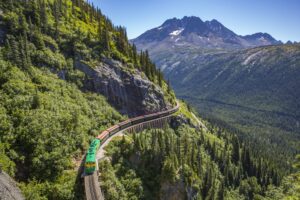White Pass & Yukon Route: Carrying cross-border tourists through history-rich backdrops of natural beauty
Posted onPulling out of the station in Skagway, Alaska, passengers aboard the White Pass & Yukon Route (WP&YR) railway are almost immediately treated with glimpses of history and vast natural beauty.
WP&YR trains climb from sea level to 3,000-feet altitude in just 10 miles. (For metric fans, that’s 914 metres in just 16.1 kilometres.)
In those early goings, passengers are treated – and enchanted – by sights like the Sawtooth Mountains, the Denver Glacier, and even the occasional bit of wildlife staring back.
“You start to realize that you’re pulling away from civilization,” says Tyler Rose, Executive Director of Human Resources & Strategic Planning at WP&YR.
The railway traces its beginnings during the Klondike Gold Rush. Construction on it began in 1898. It was reinvented as a tourist attraction in 1988.
Today, it runs through communities like Skagway, Fraser, Carcross, and Bennett on 67.5 miles (108.6km) of total track through Alaska, Yukon Territory, and British Columbia.
“We’re the only passenger railroad that goes through a state, a province, and a territory,” says Rose.
WP&YR passengers can enjoy a variety of excursions like full-day trips, one-way services, and hiker services to places like the Chilkoot Trail and Lake Bennett. Rose explains that while they have a lot of repeat riders, the majority of passengers come from cruise ships docked in Skagway.
On any excursion, passengers will be treated to reminders of the railway’s – and the region’s – rich history.
Celebrations of the railway’s 125th anniversary will span the next three years. WP&YR will commemorate milestones like trekkers making it to Lake Bennett, but also the engineering miracles and other ingenious achievements that went into creating the railway itself.
“The entire railway was built in just over two years. Nowadays, you couldn’t even permit a line in two years,” says Rose.
Rose says WP&YR says great people are a key part of the history and that multiple generations of several families have worked for the railway. WP&YR’s longest-tenured employee, Canadian roadmaster Willi Scheffler, has worked for the railway for 63 years. WP&YR currently employs 175 people.
WP&YR isn’t just looking to its past; eyes are firmly fixed on the future and the growth needed to get there.
The railway has installed a loop for its most popular summit excursion and more passing tracks that help with greater operational efficiency. WP&YR also purchased six new locomotives in 2020, and continually makes improvements aimed at making travel even more comfortable.
As with virtually every other passenger railway, WP&YR was not immune from the impacts of the COVID-19 pandemic.
“2019 was a banner year for us, but in 2020 and 2021 we had no operations. The line that I’ve heard that best describes it is ‘that there’s a big difference between being back in service and being back in business,’ says Rose.
Despite a recovery that is still underway, Rose and his colleagues are optimistic about the railway’s future.
Rose says each operating season offers passengers a special and unique experience. In the springtime, passengers might still see snowfall. The summer can bring gorgeous blue sky and sun that makes the glaciers sparkle. In the fall, the leaves change into beautiful, dynamic colours.
“Whether it’s the weather or the season, each time you take the train it’s a little bit different, and that’s amazing.”
-30-
